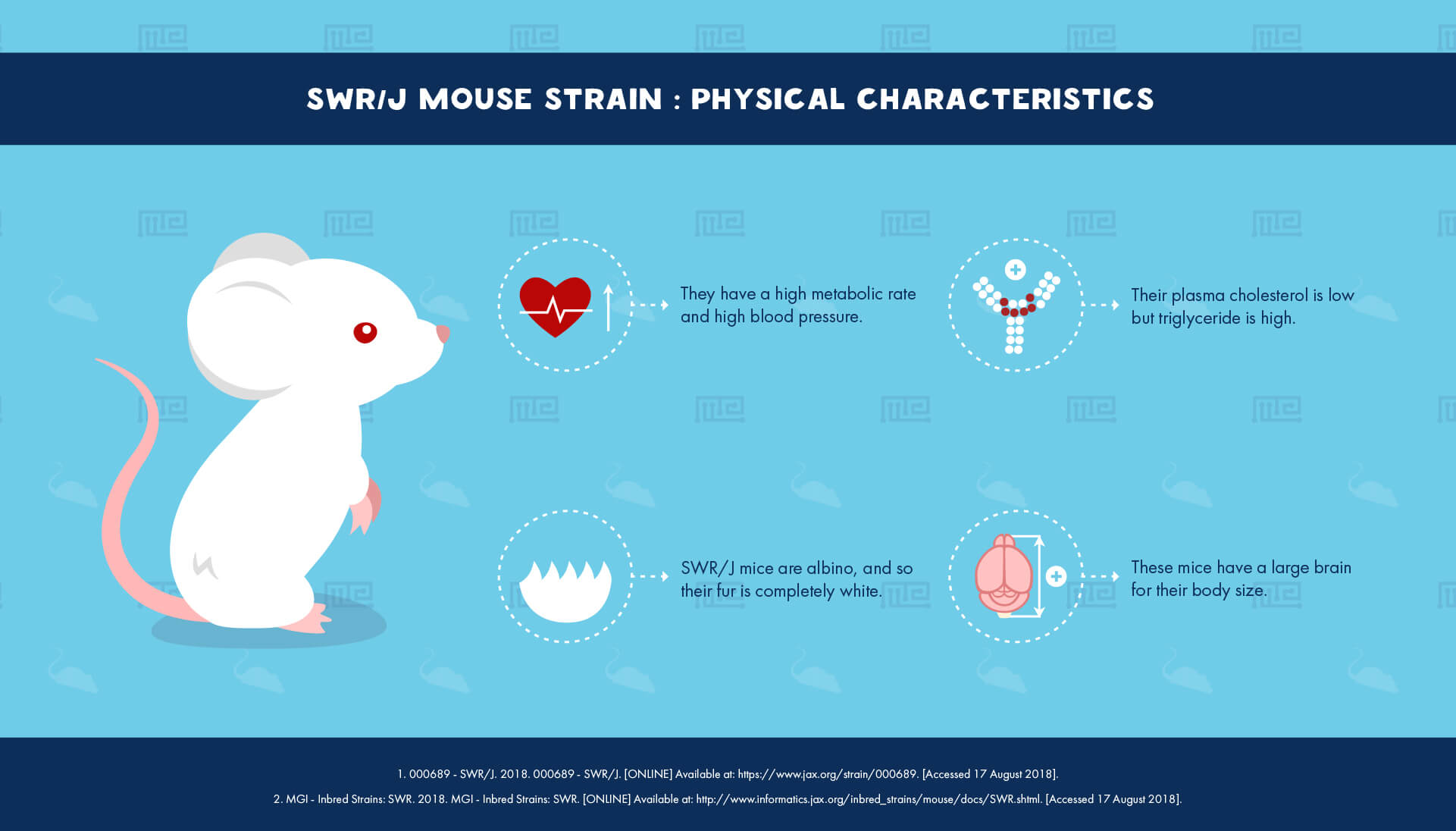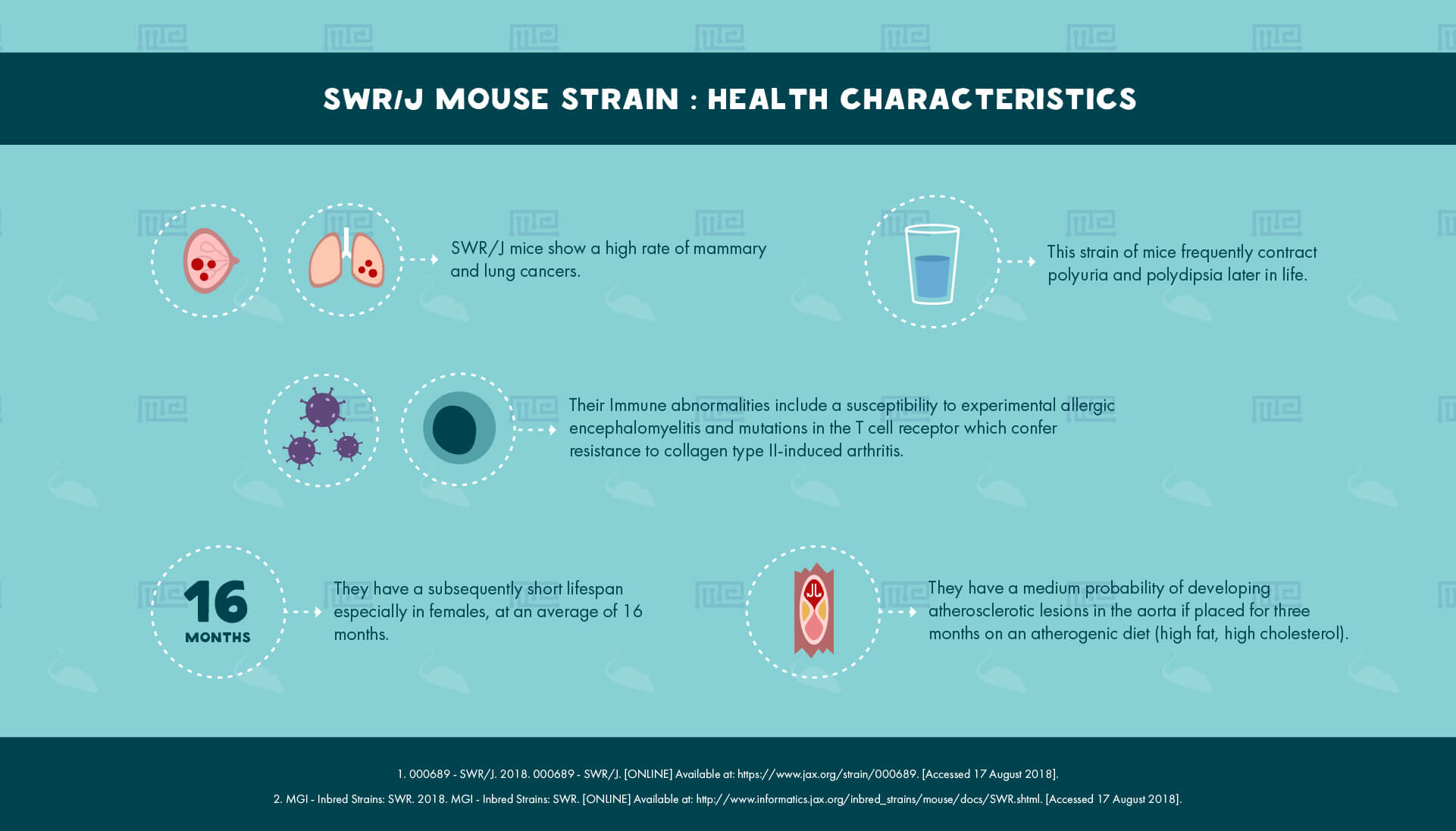Overview
SWR/J, also known as the SW or Swiss mouse, is an inbred strain of mouse model that is used in many research areas, as well as for the generation of transgenics.
History
The progenitors of this strain were obtained from Lausanne in 1926 by Clara Lynch of the Rockefeller Institute. These were also the progenitors of the NOD strain. Lynch inbred this strain, before sending them to Raymond Parker of the University of Toronto. The Jackson Laboratory obtained a stock of these mice in 1947, creating the SWR/J strain.[1]
Physical Characteristics
SWR/J mice are albino, and so their fur is completely white.[1] They have a high metabolic rate and high blood pressure. Their plasma cholesterol is low but triglyceride is high, and their carcass lipid mass is low following a high-fat diet. They have a large brain for their body size.[1][2]
Behavioral Characteristics & Handling
Researchers using this strain should take caution, and bear in mind that observations suggest it is a difficult strain to handle.
A Canadian study comparing the ease of handling of 21 commonly used mouse strains reports that SWR/J was the third least placid of all the strains (after AKR/J and CAST/Ei), displaying the second highest squeak frequency (after AKR/J), taking evasive action during capture, and struggling when held.[3]
SWR/J mice are the only inbred mouse strain that possesses the Soaa allele, known as the “bitter taste gene”, which confers avoidance of sucrose octaacetate.[1] This should be remembered if hoping to use the strain in tests such as sucrose preference.
Health Characteristics
Mice of the SWR/J strain show a high rate of mammary and lung cancers. Tumors are found in over 60% of these mice, and lung tumors develop in 80% of them by age of 18 months[1][2] Lifespan is subsequently short, especially in females (which average 16 months).[2]
Immune abnormalities include a susceptibility to EAE (experimental allergic encephalomyelitis), a disease similar to multiple sclerosis, as well as mutations in the T cell receptor which confer resistance to collagen type II-induced arthritis.[1]
They have a medium probability of developing atherosclerotic lesions in the aorta following placement for three months on an atherogenic diet (high fat, high cholesterol). They have also frequently been seen to contract polyuria and polydipsia later in life.[1]
Major Experimental Uses
The SWR/J strain has proven very useful in the generation of transgenic mice. This is a consequence of their large and easily visible nuclei with high resistance to lysis after microinjection, coupled with their good response to exogenous hormones.[1][2][4]
Mice of this strain are also highly suitable for use as controls in experiments with the NOD mouse strain. These two strains are both derived from the same Swiss mouse stock, but SWR/J mice do not exhibit the autoimmune phenotype of the NOD/ShiLtJ. They also have marked genetic differences.[1]
In addition to these two major uses, SWR/J mice find application in research on pulmonary and mammary cancer, atherosclerosis, lymphatic deficits, and retinal degeneration (as they are homozygous for a phosphodiesterase 6 mutation conferring this last condition).[1]
SWR/J mice are genetically well defined, which can make them a more reliable model than Swiss ICR mice.[1]
References
- 000689 – SWR/J. 2018. 000689 – SWR/J. [ONLINE] Available at: https://www.jax.org/strain/000689. [Accessed 17 August 2018].
- MGI – Inbred Strains: SWR. 2018. MGI – Inbred Strains: SWR. [ONLINE] Available at: http://www.informatics.jax.org/inbred_strains/mouse/docs/SWR.shtml. [Accessed 17 August 2018].
- Wahlsten, D. Metten, P. Crabbe, JC. 2003. A rating scale for the wildness and ease of handling laboratory mice: results for 21 inbred strains tested in two laboratories. Genes, Brain and Behavior. 2; 71-79.
- Osman GE1, Jacobson DP, Li SW, Hood LE, Liggitt HD, Ladiges WC. SWR: an inbred strain suitable for generating transgenic mice. Lab Anim Sci. 1997 Apr;47(2):167-71.


